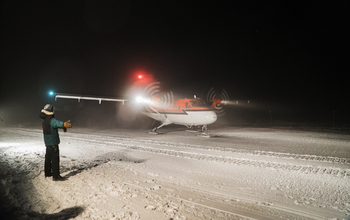Multimedia Gallery
Airplane taxis down runway at Amundsen-Scott South Pole Station
A Kenn Borek Air Ltd. Twin Otter airplane used in a rescue mission taxis down the runway at Amundsen-Scott South Pole Station. The airplane was arriving as part of a meticulously planned, carefully executed National Science Foundation-led medical evacuation that resulted in successfully evacuating two patients, despite extreme conditions.
More about this image
In June 2016, the National Science Foundation (NSF), after consulting with outside medical experts, determined that an evacuation was warranted for two people stationed at Amundsen-Scott South Pole Station. The extreme cold and darkness at this time of year in Antarctica normally means that flights in and out of the station are suspended. NSF called on Calgary-based Kenn Borek Air Ltd., which has a U.S. government contract to fly in support of U.S. Antarctic Program science, to conduct the mission.
Two Twin Otter aircraft, designed to withstand intense weather conditions, arrived at British Antarctic Survey's Rothera Station on the Antarctic Peninsula on June 20, 2016, where they rested and awaited favorable weather. On June 22, one of the aircraft arrived at the geographic South Pole. Later that day, the flight landed safely in Punta Arenas, Chile, where the evacuees would receive medical treatment. The arrival completed a nine-day global evacuation operation that NSF coordinated to prioritize the health and safety of station and rescue personnel.
"NSF is committed to supporting scientific exploration--which often requires researchers and support staff working in some of the most inhospitable places on the planet--but our top commitment is to the safety and security of the people involved in those endeavors," said NSF Director France Córdova. "This was a difficult process, and we're especially grateful to the skilled flight crew who flew almost halfway around the world and over three continents, for the South Pole Station winter crew, and all the dedicated people who facilitated this rescue. It has served as a sobering reminder of the risks research often requires, the tremendous challenges involved, and the resolve and solidarity of the scientific community."
NSF operates the Amundsen-Scott South Pole Station as part of its management of the U.S. Antarctic Program, the nation's research program on the southernmost continent. [Note: Please see special restrictions regarding use of this image, below.] (Date image taken: June 22, 2016; date originally posted to NSF Multimedia Gallery: March 1, 2017)
Credit: Robert Schwarz; source: U.S. Antarctic Program photo library
See other images like this on your iPhone or iPad download NSF Science Zone on the Apple App Store.
Special Restrictions: [Note: Any commercial use of this image requires the photographer's permission.]
Images and other media in the National Science Foundation Multimedia Gallery are available for use in print and electronic material by NSF employees, members of the media, university staff, teachers and the general public. All media in the gallery are intended for personal, educational and nonprofit/non-commercial use only.
Images credited to the National Science Foundation, a federal agency, are in the public domain. The images were created by employees of the United States Government as part of their official duties or prepared by contractors as "works for hire" for NSF. You may freely use NSF-credited images and, at your discretion, credit NSF with a "Courtesy: National Science Foundation" notation.
Additional information about general usage can be found in Conditions.
Also Available:
Download the high-resolution JPG version of the image. (1.3 MB)
Use your mouse to right-click (Mac users may need to Ctrl-click) the link above and choose the option that will save the file or target to your computer.



 All images in this series
All images in this series